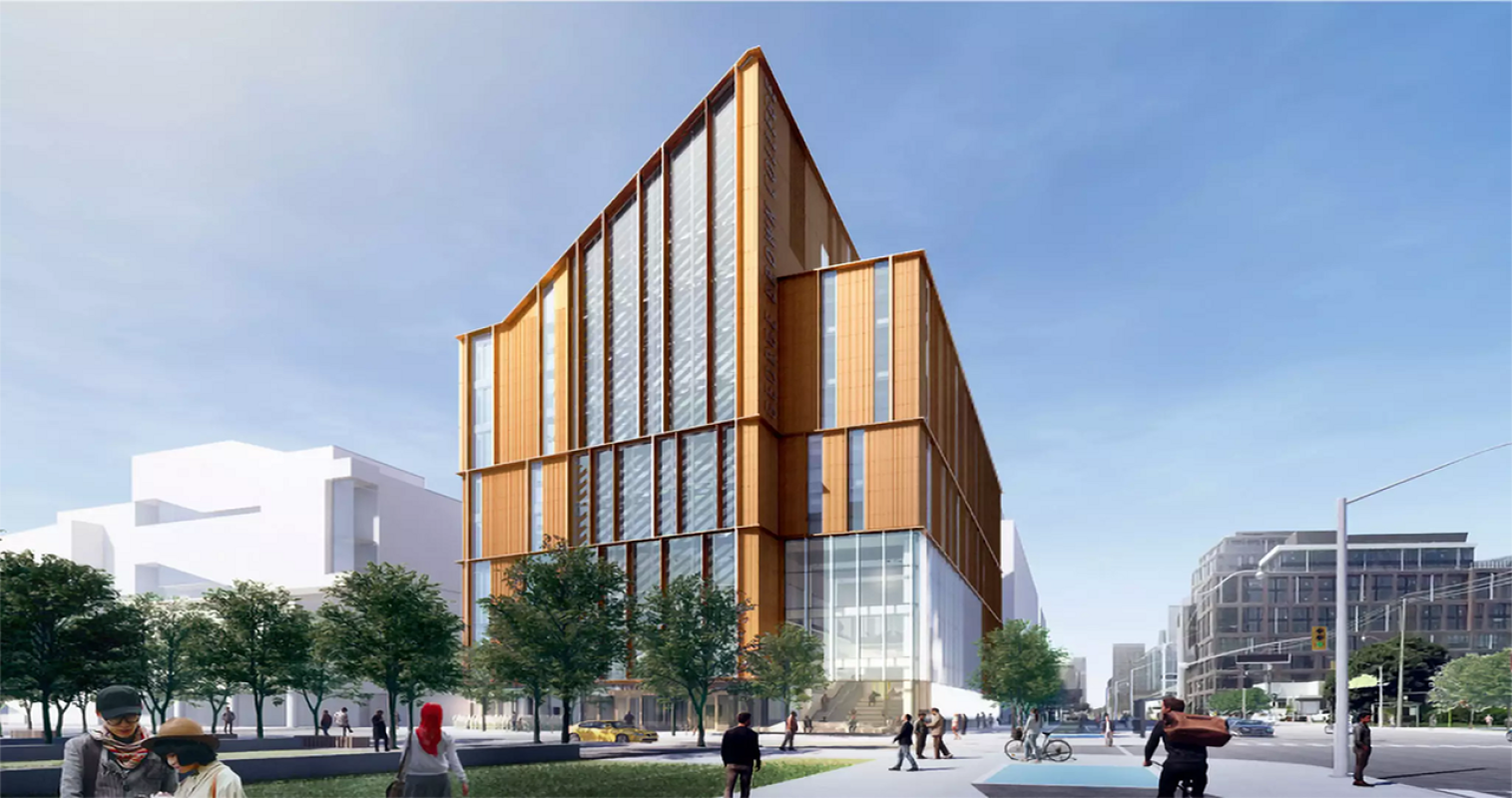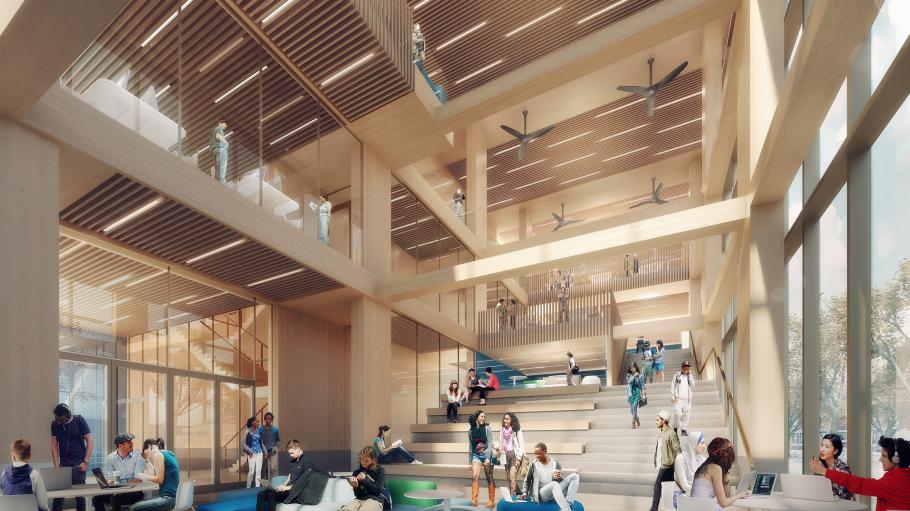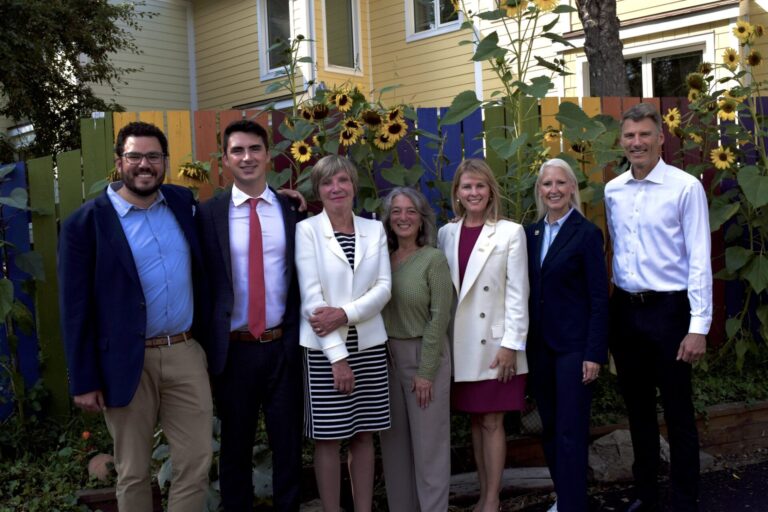Monday, September 22, 2025
As students head back to school, we are bringing you the second edition of the Spotlight on Sustainability series, thanks to our media partnership with the Ontario College and University Sustainability Professionals (OCUSP) network. The series provides a platform to share best practices, amplify impact, and reinforce the value of collaboration in advancing sustainability outcomes.
For this edition, we’re putting the spotlight on George Brown College (GBC), which has emerged as a transformative force in sustainable development, impacting not only education but also the broader construction and design sectors. Its core environmental mission focuses on spaces and systems that align with the realities of a climate-conscious future. GBC now presents a compelling model where forward-thinking design, smart material choices, and circular economy principles are actively put into practice.
From the pioneering Limberlost Place, a mass-timber beacon on Toronto’s waterfront, to innovative waste and resource programs like GO Zero, Oscar Sort the AI Recycling Assistant, and the Citronino circular economy project, GBC isn’t just meeting environmental goals it’s setting new industry benchmarks.

George Brown College’s Limberlost Place: The mass-timber building’s name was inspired by Limberlost Forest & Wildlife Reserve near Huntsville, Ontario.
Limberlost Place: A living blueprint of low-carbon construction
Standing 10 storeys high at the college’s Waterfront Campus, Limberlost Place is Ontario’s first tall wood institutional building constructed using mass timber, and one of Canada’s academic facilities targeting net-zero carbon emissions. Designed in collaboration with Moriyama Teshima Architects and Acton Ostry Architects and built by PCL Constructors, Limberlost demonstrates GBC’s ongoing commitment to its strategic investment in sustainable innovation.
Limberlost integrates prefabricated construction, electrified systems, and passive energy strategies within an academic environment that also serves as a research and innovation hub.
Rather than rely on traditional steel-and-concrete framing, Limberlost’s structure is a mass timber and steel hybrid, comprised of 1,190 cross-laminated timber (CLT) and 571 glulam components some spanning multiple storeys. These prefabricated components were produced with precision, enabling just-in-time delivery and rapid, efficient assembly on-site. This method reduced waste and labour hours, ensuring tighter construction tolerances and directly enhanced the building’s energy efficiency.
Unlike traditional buildings, Limberlost Place is entirely electrified and operates with zero on-site fossil fuels. It draws energy from a combination of deep lake water cooling provided by Enwave, rooftop solar photovoltaic panels, and advanced passive ventilation systems. Notably, the building’s solar chimneys improve airflow and reduce mechanical load, showcasing how architectural form can double as environmental function. Limberlost Place also incorporates additional passive technologies including daylight and storm water harvesting. Daylight harvesting maximizes natural light while limiting heat gain, allowing light levels to be reduced by 60 per cent. Storm water is collected in an on-site cistern, treated, and reused for toilets, urinals and landscape irrigation further minimizing the building’s environmental footprint.
Another crucial layer of sustainability is embedded in its envelope. The building incorporates lean envelope design with high-performance windows and exterior panels that were also prefabricated off-site. This significantly reduces construction waste and allows for superior thermal and moisture control.
To ensure that the performance matches the ambition, Limberlost Place employs real-time sensor technology that continuously monitors air quality, energy use, daylighting, and thermal conditions. These insights not only guide operational efficiencies but feed directly into curriculum and research for students in design, construction, and building sciences creating a true living laboratory.
Institutional Impact: Shaping codes, training, and market norms
Beyond construction techniques, Limberlost Place has been instrumental in influencing building code evolution. At the time of the building’s conception, the Ontario Building Code limited tall wood buildings to six storeys. GBC’s commitment to pushing this boundary supported by Natural Resources Canada and the Ontario government resulted in regulatory flexibility that paved the way for more mid- and high-rise wood buildings across the country.
Limberlost is more than just a design case study; it’s proof of concept that sustainable buildings can influence legislative change, unlock new market opportunities, and redefine the possibilities of vertical wood construction in institutional settings.
Moreover, the project’s integrated design process included early engagement with facilities management and sustainability advisors. This approach ensured that lifecycle costs, maintenance considerations, and carbon accounting were embedded into every stage of planning and construction another valuable takeaway for professionals aiming to design resilient, long-lasting buildings.
Expanding the Sustainability Ecosystem: GBC’s broader initiatives
While Limberlost Place stands as a tangible symbol of sustainable construction, GBC’s broader commitment to environmental responsibility is equally forward-thinking and impactful. Across its campuses, the college has launched several initiatives that integrate environmental stewardship into its daily operations.
GO Zero: Rethinking PPE waste
Amid the COVID-19 pandemic, the increase in single-use personal protective equipment (PPE) created an urgent waste management problem. GBC responded with GO Zero, a program that collects and recycles used masks, gloves, and other PPE materials that typically end up in landfills.
The college established specialized PPE collection stations in its Health Sciences labs and clinics. These materials are then processed using advanced separation and recycling technologies, diverting significant volumes of waste and helping to reduce contamination risks in regular waste streams.
Oscar Sort: Artificial Intelligence (AI) meets waste diversion
Oscar Sort, developed by Intuitive AI, is an AI-powered Recycling Assistant that attaches to campus bins with a smart screen and camera. Using computer vision, it guides users to sort waste correctly in real time, making recycling simple and engaging.
The results are significant: Oscar increases sorting accuracy to 96 per cent, decreases contamination, enhances material recovery, and supports zero-waste goals. For large facilities and municipalities, it offers a modular, tech-forward solution that drives behaviour change and optimizes waste management.
 A team of over 250 GBC students and faculty, alongside help from Reid’s Distillery, have created a solution that allows wasted food scraps to be turned into a small-batch liqueur that they’ve called Citronino.
A team of over 250 GBC students and faculty, alongside help from Reid’s Distillery, have created a solution that allows wasted food scraps to be turned into a small-batch liqueur that they’ve called Citronino.
Citronino: Circular economy in action
Sustainability at GBC also includes creative industry partnerships, such as Citronino, a circular economy initiative launched through the Centre for Hospitality and Culinary Arts. In collaboration with Reid’s Distillery, the program collects citrus peel waste from student kitchens and repurposes it into a unique craft spirit.
This initiative diverts over 100 pounds of citrus waste per production cycle, reducing organic waste while engaging students in sustainability-focused product development, branding, and marketing. Citronino is a model of how waste can be transformed into opportunity.
A model for sustainable institutions
What makes GBC’s sustainability story so compelling is its combination of high-performance buildings, innovative resource recovery, and system-wide thinking. Whether it’s developing new low-carbon construction templates through Limberlost Place or embracing AI and circular design in daily operations, GBC exemplifies how sustainability can be embedded not just implemented.
Lessons Learned: Key takeaways for industry
With these examples in mind, some key takeaways for industry professionals include:
- Electrification is viable now at scale, especially when paired with renewable energy and passive design.
- Mass timber construction, supported by prefabrication and precision engineering, offers a replicable model for faster, cleaner institutional builds.
- AI-assisted waste systems like Oscar Sort are ready for deployment in public facilities, campuses, and commercial settings.
- Circular economy partnerships like Citronino create measurable waste reductions and offer PR and engagement value.
- Policy and code influence can stem from projects that challenge norms providing both proof of concept and momentum for industry-wide change.
George Brown College is not merely teaching sustainability it is building it into the foundation of its infrastructure, operations, and pedagogy. GBC offers an invaluable case study in how to design, deliver, and operate projects that are not only environmentally responsible but also economically smart, replicable, and regulation-shaping.
As climate imperatives continue to evolve, so too must industry. Institutions like GBC are leading the way, and for those ready to partner, build, or consult in this space, the future is already here.
For further information, click here.
This article was written by the following authors from George Brown College:

Mary Livera, Director of Sustainability

Nerys Rau, Executive Director of Facilities and Sustainability

Vicky Boyd, Sustainability Engagement and Compliance Coordinator

Matthew Archdekin, Energy Management Specialist at George Brown College
Featured photos courtesy of George Brown College.
Don’t miss the next edition of Spotlight on Sustainability! Register for your free subscription here.












